The Lion of Lucerne | A Tribute to Courage and Sacrifice by Bertel Thorvaldsen
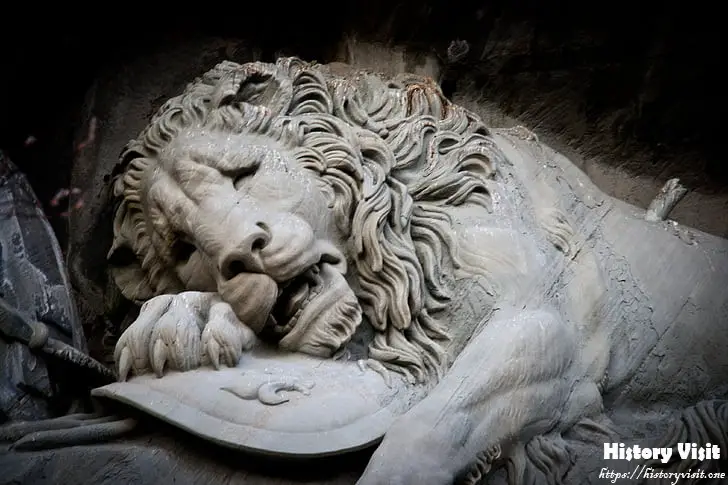
Introduction
The Lion Monument, also known as the Lion of Lucerne, is a poignant and iconic rock relief located in Lucerne, Switzerland. This remarkable sculpture commemorates the Swiss Guards, who met a tragic fate during the French Revolution in 1792. These brave guards were stationed at the Tuileries Palace in Paris, where they valiantly defended their post. However, they were ultimately overwhelmed by superior numbers and faced dire circumstances. Around 760 Swiss Guards lost their lives during the fighting or were massacred after surrender.
The sculpture portrays a mortally wounded lion, its noble head resting on a shield bearing the fleur-de-lis, the emblem of the French monarchy. The Lion Monument stands as a powerful symbol of courage, loyalty, and sacrifice, evoking strong emotions in visitors from around the world.
Bertel Thorvaldsen, a Danish sculptor, is the mastermind behind the Lion Monument. Born in 1770, Thorvaldsen gained international acclaim for his neoclassical sculptures and monumental works. His artistic prowess extended beyond national borders, and he became a prominent figure in European art during the early 19th century.
Now, let’s delve into the historical context surrounding the creation of the Lion Monument:
- French Revolution and the Swiss Guards:
- The French Revolution (1789–1799) was a period of radical political and social upheaval in France.
- The Swiss Guards, a contingent of Swiss soldiers, served as the personal bodyguards of the French monarchy.
- In 1792, during the 10th of August Insurrection, revolutionaries stormed the Tuileries Palace in Paris, where the Swiss Guards were stationed.
- Despite their valiant defense, the Swiss Guards were outnumbered and faced dire circumstances.
- Tragic Fate of the Swiss Guards:
- Around 760 Swiss Guards lost their lives during the fighting or were massacred after surrendering.
- Their unwavering loyalty and sacrifice left a profound impact on history.
- The Lion Monument’s Creation:
- In the early 19th century, Lucerne, a picturesque Swiss city, decided to honor the fallen Swiss Guards.
- Thorvaldsen’s design for the Lion Monument was chosen to commemorate their bravery.
- The monument was meticulously carved into a sandstone rock face between 1820 and 1821 by the skilled sculptor Lukas Ahorn.
- Symbolism and Emotional Impact:
- The sculpture portrays a mortally wounded lion, its head resting on a shield bearing the fleur-de-lis, symbolizing the French monarchy.
- The lion represents courage, loyalty, and sacrifice.
- Visitors from around the world are deeply moved by the monument’s poignant portrayal of loss and heroism.
Thorvaldsen’s Lion of Lucerne stands as a timeless tribute to those who gave their lives in service, leaving an indelible mark on both art and history.
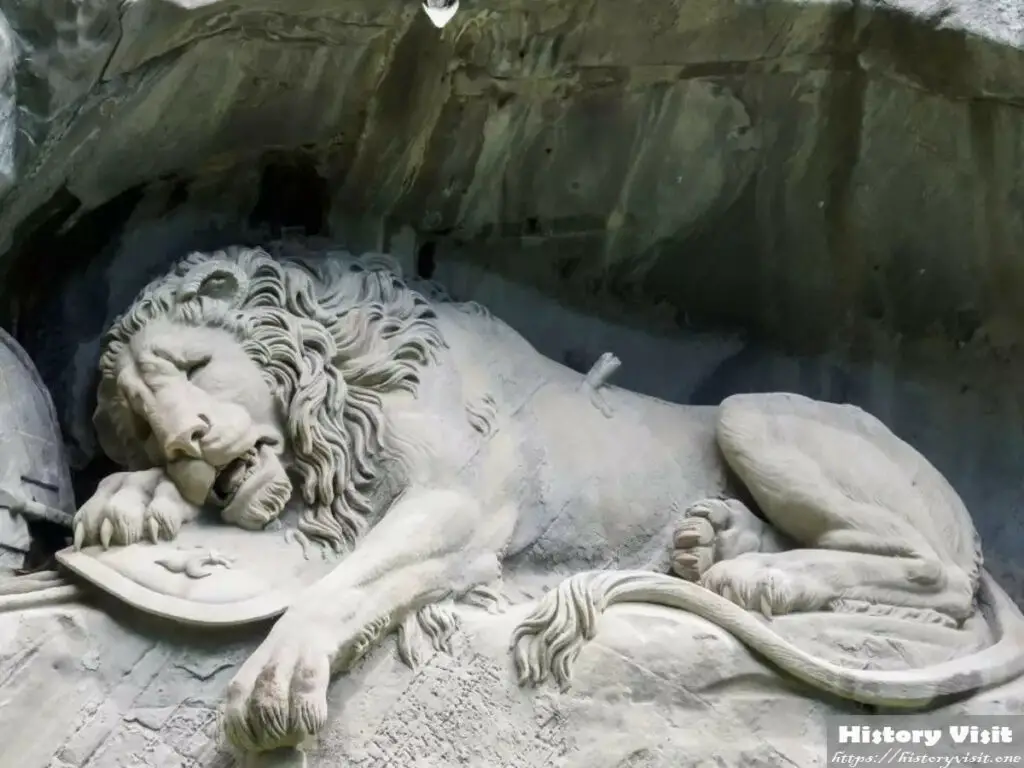
Historical Background
During the 17th century, the Swiss Guards played significant roles both in France and beyond. Let’s explore their contributions:
- Service to Foreign Rulers:
- In 1471, King Louis XI initiated a tradition by establishing the “Hundred Swiss”, the first permanent Swiss unit in the service of a foreign ruler.
- These “Cent-suisses” served primarily as guards within royal palaces.
- While they were not primarily used for military purposes, they became a prominent parade corps.
- Guarding the Kings of France:
- The Swiss Guards (Gardes Suisses) were responsible for guarding the entrances and outer perimeter of the French royal palaces.
- During wartime, they also served as a fighting regiment in the field.
- Their discipline and steadiness were renowned during the 17th and 18th centuries.
- Swiss Guards held a higher rate of pay compared to regular French soldiers, and their officers were exclusively Swiss.
- Origins and Papal Service:
- In the late 14th and 15th centuries, Swiss mercenaries began serving the Papal States.
- In 1506, the first contingent of 150 Swiss guardsmen, led by Captain Kaspar von Silenen, arrived at the Vatican.
- Acting on behalf of Pope Julius II, the Swiss bishop (later cardinal) Matthäus Schiner proposed the creation of a permanent Swiss contingent directly under the pope’s control.
- Distinctive Uniforms and Traditions:
- The Swiss Guards’ uniforms are among the oldest in continuous use.
- Contrary to legend, Michelangelo probably did not design them.
- Their tunics feature stripes in the colors of the Medici family: red, dark blue, and yellow.
- White ruffs, high plumed helmets, and armor are also part of their ceremonial attire.
- While in traditional dress, they carry pikes and swords, but they are also trained in modern weaponry and counterterrorism techniques.
- Current Role:
- Today, the Swiss Guards continue to serve as personal escorts to the pontiff (the pope) and as watchmen for Vatican City and the pontifical villa of Castel Gandolfo.
- Their unwavering loyalty and historical significance make them a unique and revered force within the Vatican.
The Swiss Guards’ legacy extends beyond their military duties, embodying courage, loyalty, and a rich historical connection between Switzerland and the papacy.
During the French Revolution, the Swiss Guards found themselves at the heart of a momentous and tragic episode while stationed at the Tuileries Palace in central Paris. Let’s delve into the historical context and events surrounding their defense:
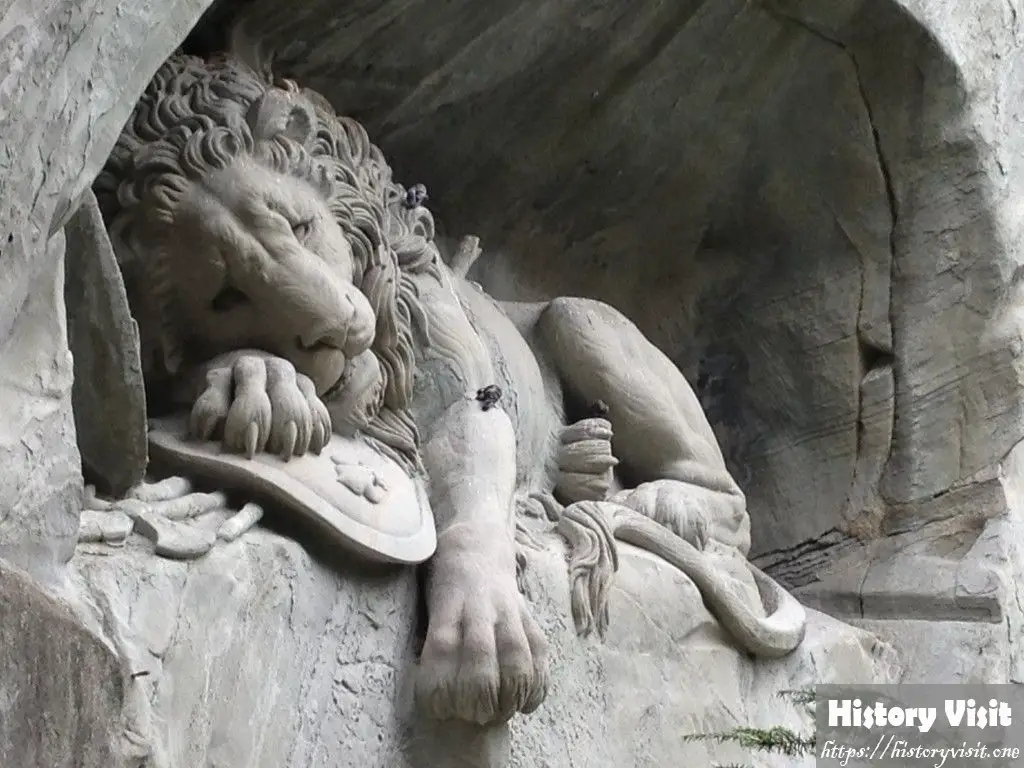
- Role of Swiss Guards in France:
- The Swiss Guards had historically served as mercenaries in various European armies, including that of France.
- In France, two distinct units of Swiss mercenaries performed guard duties for the Kings of France:
- Hundred Swiss (Cent Suisses): They primarily served in the palace as bodyguards and ceremonial troops.
- Swiss Guards (Gardes Suisses): These guards were responsible for guarding entrances and the outer perimeter of the palace.
- Additionally, the Swiss Guards also served as a fighting regiment in times of war.
- The Tragic Episode at the Tuileries Palace (August 10, 1792):
- On this fateful day, the French Revolutionaries stormed the Tuileries Palace where King Louis XVI and his family resided.
- Approximately 900 Swiss Guards were stationed there.
- Despite their valiant efforts, about 600 Swiss Guards lost their lives during the fighting or were massacred after they surrendered.
- This tragic event left an indelible mark on the history of the Swiss Guards and the French Revolution.
- Legacy and Impact:
- The defense of the Tuileries Palace by the Swiss Guards became one of the most famous and poignant episodes in their history.
- Their sacrifice symbolized loyalty, courage, and the harsh realities faced during a tumultuous period.
The Swiss Guards’ unwavering commitment to duty and their tragic fate at the Tuileries Palace remain etched in historical memory.
The 10th of August Insurrection in 1792 was a defining event during the French Revolution. Armed revolutionaries in Paris, increasingly in conflict with the French monarchy, stormed the Tuileries Palace. Let’s delve into the dramatic events of that pivotal day:
- Context and Tensions:
- Throughout the spring and summer of 1792, tensions escalated between King Louis XVI of France and the newly established revolutionary Legislative Assembly.
- Louis repeatedly vetoed radical measures passed by the Assembly.
- On August 1, news reached Paris that the commander of the allied Prussian and Austrian armies had issued the Brunswick Manifesto, threatening “unforgettable vengeance” on Paris if harm befell the French monarchy.
- The Storming of the Tuileries Palace (August 10, 1792):
- On August 10, the National Guard of the Paris Commune and fédérés (volunteers) from Marseille and Brittany launched an assault on the Tuileries Palace.
- The palace was defended by the Swiss Guards, who valiantly tried to protect the royal family.
- In the ensuing battle, hundreds of Swiss guardsmen and about 400 revolutionaries lost their lives.
- King Louis XVI and the royal family sought refuge with the Legislative Assembly.
- Fall of the Monarchy and Establishment of the Republic:
- The formal end of the monarchy occurred six weeks later, on September 21, 1792.
- The new National Convention declared France a republic.
- Legacy and Common Designations:
- Historians often refer to this event simply as “the 10 August.”
- Other common designations include “the day of the 10 August” (French: journée du 10 août) or “the Second Revolution.”
The storming of the Tuileries Palace marked a turning point, leading to the abolition of the monarchy and the establishment of a new era in French history.
The Swiss Guards, stationed at the Tuileries Palace during the French Revolution, faced a harrowing fate. Let us delve into their tragic story:
- The Battle at Tuileries Palace (August 10, 1792):
- On that fateful day, revolutionaries stormed the Tuileries Palace in Paris.
- Approximately 900 Swiss Guards valiantly defended the palace against overwhelming odds.
- Despite their courage, they were outnumbered and outgunned.
- Losses During the Battle:
- In the intense fighting, about 600 Swiss Guards lost their lives.
- Many fell defending the royal family and the monarchy.
- Their unwavering loyalty and sacrifice left an indelible mark on history.
- Subsequent Massacres:
- After the battle, the surviving Swiss Guards were taken prisoner.
- Tragically, they faced further brutality.
- Some were executed on the spot, while others were subjected to summary trials.
- The revolutionaries’ anger and vengeance spared no one.
- Symbolism and Remembrance:
- The Lion Monument in Lucerne, Switzerland, immortalizes their sacrifice.
- The mortally wounded lion, head resting on a shield, symbolizes courage and loyalty.
- Visitors pay homage to these fallen heroes, moved by their tragic fate.
The Swiss Guards’ bravery and tragic end serve as a reminder of the tumultuous times and the human cost of revolution.
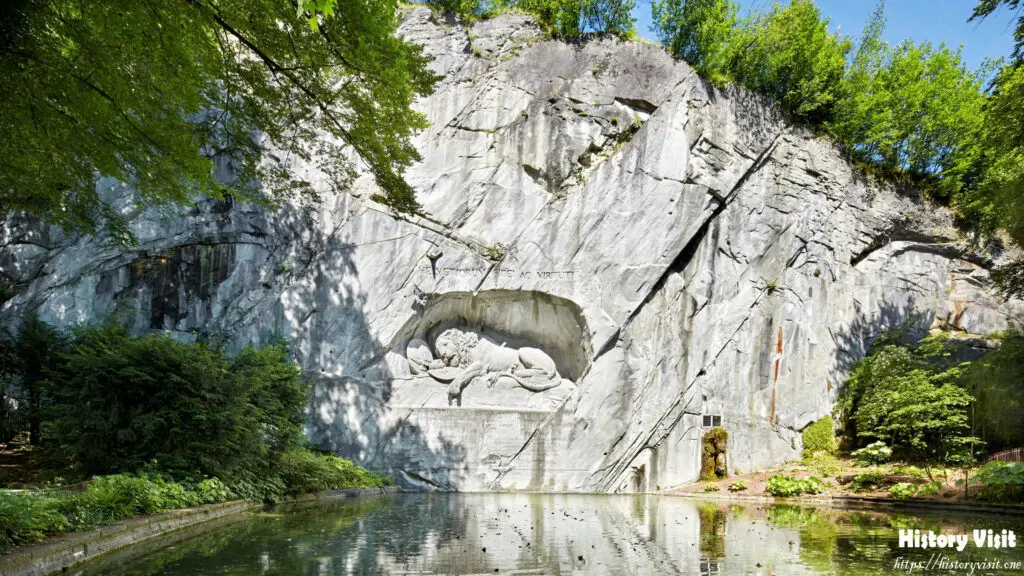
The Monument Itself
The Lion Monument, also known as the Lion of Lucerne, is a remarkable rock relief located in Lucerne, Switzerland. Here are the key details about this poignant memorial:
- Design and Sculpture:
- The Lion Monument was designed by the renowned Danish sculptor Bertel Thorvaldsen.
- It was meticulously hewn into a sandstone rock face between 1820 and 1821 by the skilled sculptor Lukas Ahorn.
- The sculpture portrays a mortally wounded lion lying down, its noble head resting on a shield bearing the fleur-de-lis, which represents the French monarchy.
- Location:
- The Lion Monument is situated along Denkmalstrasse (Monument Street), just outside the old city of Lucerne.
- Its precise coordinates are approximately 47.05833°N, 8.31056°E.
- Carved directly into the wall of a former sandstone quarry, the monument blends seamlessly with its natural surroundings.
- Symbolism and Commemoration:
- The Lion Monument commemorates the Swiss Guards who were tragically massacred in 1792 during the French Revolution.
- These brave guards had defended the Tuileries Palace in Paris, but they were overwhelmed by superior numbers.
- The monument symbolizes courage, loyalty, and sacrifice, evoking strong emotions in visitors.
- Visitors and Recognition:
- The Lion of Lucerne is one of the most famous monuments in Switzerland.
- Approximately 1.4 million tourists visit it annually.
- In 2006, it was placed under Swiss monument protection, ensuring its preservation for future generations.
- Emotional Impact:
- Mark Twain aptly described the sculpture as “the most mournful and moving piece of stone in the world.”
- The regal beast’s dying pose and the shield with the fleur-de-lis evoke a sense of tragedy and heroism.
The Lion Monument stands as a powerful tribute to those who sacrificed their lives, leaving an indelible mark on Lucerne’s history and the hearts of all who visit.
Certainly! The Lion Monument owes its exquisite form to the skilled hands of the sculptor Lukas Ahorn. With meticulous precision, Ahorn transformed Bertel Thorvaldsen’s design into a timeless rock relief that now stands as a powerful tribute in Lucerne, Switzerland. The lion’s noble head resting on the shield, the emblem of the French monarchy, bears witness to Ahorn’s artistry and the enduring impact of this poignant memorial.
Let me vividly depict the Lion Monument in Lucerne, Switzerland:
- The Lion’s Form:
- Carved into a sandstone rock face, the sculpture portrays a majestic lion.
- The lion lies there, its once powerful body now mortally wounded.
- Its massive paws extend forward, as if still trying to protect something precious.
- The Head and Expression:
- The lion’s noble head is lowered, conveying both dignity and suffering.
- Its eyes are closed, perhaps in eternal rest or as a silent witness to the tragedy it represents.
- The sculptor captured the lion’s regal features, emphasizing its strength even in defeat.
- The Shield and Fleur-de-lis:
- Beneath the lion’s head rests a shield.
- On this shield, meticulously carved, we find the fleur-de-lis—the iconic emblem of the French monarchy.
- The fleur-de-lis symbolizes both the royalty and the tragic fate of those who defended it.
- Symbolism and Emotion:
- The Lion Monument stands as a powerful memorial to the Swiss Guards who sacrificed their lives during the French Revolution.
- It evokes a sense of courage, loyalty, and the human cost of conflict.
- Visitors are moved by its poignant portrayal of loss and heroism.
Lukas Ahorn’s meticulous craftsmanship immortalized this scene, ensuring that the lion’s legacy endures through the ages
The Lion Monument, with its portrayal of a mortally wounded lion resting its head on a shield bearing the fleur-de-lis, encapsulates profound symbolism:
- Courage:
- The lion, despite its mortal wounds, embodies courage.
- It fought valiantly, defending its post until the very end.
- Its dignified posture reflects the bravery of those who face adversity head-on.
- Loyalty:
- The lion’s loyalty is twofold:
- Loyalty to Duty: The Swiss Guards were fiercely loyal to their duty, defending the Tuileries Palace even when outnumbered.
- Loyalty to Monarchy: The fleur-de-lis on the shield represents loyalty to the French monarchy.
- Their unwavering commitment transcended personal safety.
- The lion’s loyalty is twofold:
- Sacrifice:
- The lion’s sacrifice is palpable.
- It lies there, wounded, having given its all.
- The monument immortalizes the Swiss Guards who sacrificed their lives during the French Revolution.
In this poignant scene, the lion becomes a timeless symbol of courage, loyalty, and the ultimate sacrifice—a tribute to those who faced adversity with unwavering resolve.
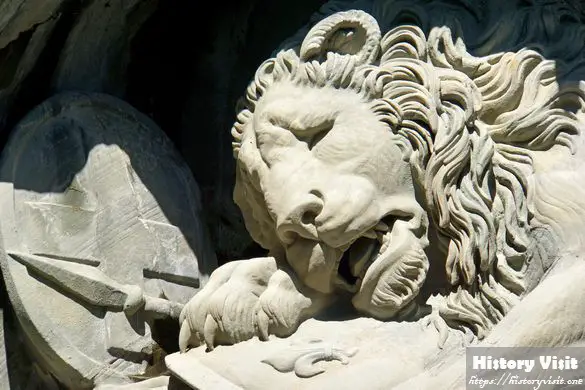
Emotional Impact
Mark Twain, the celebrated American author and humorist, eloquently described the Lion Monument in Lucerne as “the most mournful and moving piece of stone in the world.” His poignant words capture the emotional impact of this remarkable sculpture—a tribute to courage, loyalty, and sacrifice.
Visitors to the Lion Monument in Lucerne are profoundly moved by its poignant portrayal of loss and heroism. Here’s why:
- Emotional Impact:
- As visitors approach the monument, they encounter the mortally wounded lion lying there.
- The lion’s noble head resting on the shield, bearing the fleur-de-lis, evokes a sense of tragedy and sacrifice.
- Many find themselves unexpectedly choked up, feeling the weight of history and the human cost of conflict.
- Universal Themes:
- The Lion of Lucerne transcends national boundaries.
- It speaks to universal themes of courage, loyalty, and the price of duty.
- Visitors from diverse backgrounds connect with these timeless values.
- Silent Tribute:
- People stand before the lion in silence, contemplating its meaning.
- Some leave flowers or tokens of remembrance.
- The monument becomes a place for quiet reflection and honoring those who gave their lives.
- Educational Significance:
- The Lion Monument serves as an educational tool.
- It prompts discussions about history, revolution, and the impact of war.
- School groups and tourists alike learn about the Swiss Guards’ sacrifice.
- Mark Twain’s Words:
- Mark Twain’s description—“the most mournful and moving piece of stone in the world”—resonates with visitors.
- His praise captures the emotional intensity felt by those who witness the lion’s silent testimony.
In essence, the Lion Monument stands not only as a work of art but also as a living memorial, inviting us to remember, reflect, and honor the fallen.
Tourist Attraction
The Lion Monument in Lucerne, Switzerland, stands as a magnet for tourists, drawing approximately 1.4 million visitors annually. Its poignant portrayal of courage, loyalty, and sacrifice resonates with people from all walks of life. As they stand before the mortally wounded lion, they pay silent tribute to those who gave their lives—a powerful and enduring connection across time and borders.
Certainly! Since 2006, the Lion Monument in Lucerne, Switzerland, has been officially protected as a significant cultural and historical site. This designation ensures its preservation for future generations, allowing visitors to continue paying homage to the bravery and sacrifice of the Swiss Guards.
Controversies and Interpretations

The Lion Monument in Lucerne, Switzerland, has not been without its share of controversies and differing historical perspectives. Let’s delve into some of these aspects:
- Political Controversy and Glorification:
- Even before the monument was built, it sparked controversy due to its political message.
- Some critics viewed it as glorifying the ancien régime (the old regime) and the Swiss Guards who served a foreign monarchy.
- The monument’s association with the fallen guards raised questions about whether it was appropriate to honor those who died defending a monarchy during a time of revolution.
- Mixed Reception:
- The Lion of Lucerne elicited a combination of praise, national pride, and public criticism.
- While many admired its artistic beauty and emotional impact, others were displeased that a monument was built to honor Swiss citizens who died for a foreign monarchy.
- The debate over its significance continues to this day.
- Historical Accuracy and Numbers:
- The exact number of Swiss Guards who died during the French Revolution remains a point of contention.
- Early accounts suggested that around 760 Swiss Guards were killed during the fighting or massacred after surrender.
- However, late 20th-century research indicates that this number might be too high.
- Regardless, the monument serves as a powerful symbol of their sacrifice.
- Legacy and Interpretations:
- Some argue that the Lion Monument perpetuates a romanticized view of the Swiss Guards’ loyalty and sacrifice.
- Others appreciate it as a solemn reminder of the human cost of conflict.
- Interpretations vary, reflecting differing historical perspectives.
In summary, the Lion Monument’s controversial history adds depth to its significance, inviting visitors to engage with its layers of meaning.
The Lion of Lucerne, with its solemn and poignant presence, continues to resonate deeply with visitors, evoking a range of emotions and interpretations:
- Grief and Loss:
- Many viewers experience a profound sense of grief when standing before the mortally wounded lion.
- The sculpture’s portrayal of sacrifice and suffering reminds us of the human cost of conflict.
- Visitors connect with the tragedy faced by the Swiss Guards during the French Revolution.
- Heroism and Loyalty:
- The lion embodies heroism—a symbol of unwavering courage in the face of overwhelming odds.
- Its loyalty to duty and the French monarchy is both admirable and heartbreaking.
- Viewers recognize the Guards’ sacrifice as an act of profound loyalty.
- Reflection and Contemplation:
- The Lion Monument invites reflection.
- Visitors pause, contemplating the weight of history and the fleeting nature of life.
- The silence around the sculpture allows for personal introspection.
- Artistic Beauty and Craftsmanship:
- Beyond its symbolism, the Lion of Lucerne is a masterpiece of sculptural art.
- Its intricate details—the lion’s fur, the shield, and the fleur-de-lis—captivate viewers.
- The craftsmanship by Lukas Ahorn and Thorvaldsen’s design evoke admiration.
- National Identity and Commemoration:
- For the Swiss, the monument represents national identity.
- It commemorates the Guards’ sacrifice and their role in Swiss history.
- Locals and tourists alike honor this legacy.
- Controversies and Interpretations:
- Some interpret the monument as a glorification of a foreign monarchy.
- Others see it as a universal tribute to sacrifice and duty.
- These differing viewpoints enrich discussions around its meaning.
In essence, the Lion of Lucerne transcends time, inviting us to remember, empathize, and engage with the complexities of human experience.
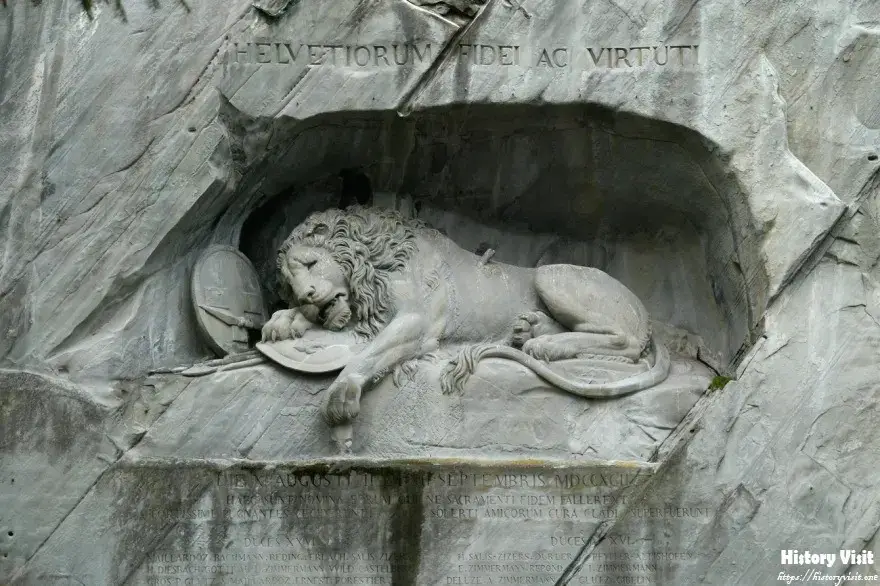
References in Literature and Culture
The Lion Monument in Lucerne, Switzerland, has left an indelible mark on literature, art, and cultural contexts. Here are some notable examples:
- Thomas Carlyle’s Description:
- In his work “The French Revolution: A History” (1837), the Scottish historian and essayist Thomas Carlyle vividly describes the monument.
- His words capture the emotional impact of the lion’s portrayal and its significance in history.
- Elinor Brent-Dyer’s Novel:
- In “The Chalet School Does It Again” (1955), author Elinor Brent-Dyer weaves the Lion Monument into her novel.
- She provides historical context, narrates its creation, and explores the associated chapel.
- Through her storytelling, she brings the monument to life for her readers.
- Artistic Inspiration:
- Over the years, the Lion Monument has served as a muse for artists, writers, and poets.
- Its deep symbolism and powerful imagery have been captured in paintings, photographs, and literary works.
- Artists have sought to convey its emotional impact and historical significance through their creative expressions.
- Universal Symbolism:
- Beyond specific references, the Lion of Lucerne has become a universal symbol.
- It represents courage, loyalty, and the human cost of conflict.
- Its enduring legacy continues to inspire and resonate across cultures and artistic forms.
In essence, the Lion Monument transcends its physical presence, leaving an imprint on the collective imagination—a testament to the power of art and remembrance.
Conclusion
The Lion of Lucerne, with its solemn and poignant presence, stands as a timeless memorial and a universal symbol of sacrifice. Here’s why its impact endures:
- Historical Remembrance:
- The monument commemorates the Swiss Guards who gave their lives during the French Revolution.
- Their unwavering loyalty and courage are etched into the stone, ensuring they are never forgotten.
- Emotional Connection:
- Visitors from around the world are deeply moved by the lion’s portrayal.
- Its grief, heroism, and tragedy evoke strong emotions.
- The silence around the sculpture allows for personal contemplation.
- Artistic Beauty:
- Beyond its symbolism, the Lion of Lucerne is a masterpiece of sculptural art.
- Its intricate details—the lion’s fur, the shield, and the fleur-de-lis—captivate viewers.
- Universal Themes:
- The lion transcends national boundaries.
- It speaks to universal themes of courage, loyalty, and the price of duty.
- Its legacy resonates across cultures and generations.
In essence, the Lion Monument invites us to remember, reflect, and honor those who sacrificed—their memory forever etched in stone.



The Lion of Lucerne | A Tribute to Courage and Sacrifice by Bertel Thorvaldsen – History Visit
Your posts in this blog really shine! Glad to gain some new insights, which I happen to also cover on my page.